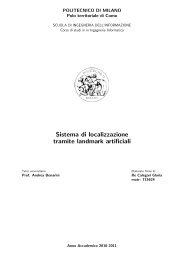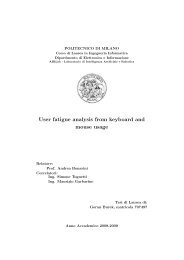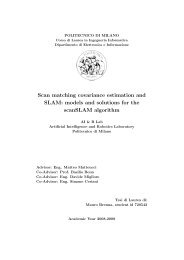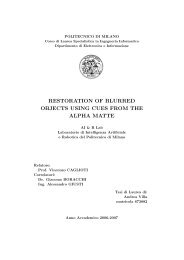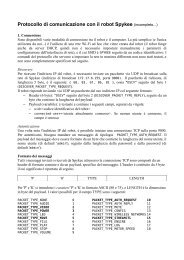Submitted version of the thesis - Airlab, the Artificial Intelligence ...
Submitted version of the thesis - Airlab, the Artificial Intelligence ...
Submitted version of the thesis - Airlab, the Artificial Intelligence ...
You also want an ePaper? Increase the reach of your titles
YUMPU automatically turns print PDFs into web optimized ePapers that Google loves.
5.2. Color Definition 61<br />
Ano<strong>the</strong>rautomaticadjustmentcanbedoneonexposure. Subjectslighter<br />
than middle gray, such as a white china plate, reflect more than 18% <strong>of</strong> <strong>the</strong><br />
light falling on <strong>the</strong>m. The exposure system doesn’t know that <strong>the</strong> scene<br />
should look bright, so it calculates an exposure that produces a middle gray<br />
image that is too dark. Subjects that are darker than middle gray such as<br />
black cloth, reflect less than 18% <strong>of</strong> <strong>the</strong> light falling on <strong>the</strong>m. The exposure<br />
system calculates an exposure that makes <strong>the</strong> image middle gray and too<br />
light.<br />
The contrast or difference in brightness between <strong>the</strong> subject and <strong>the</strong><br />
background can fool an exposure system, particularly if <strong>the</strong> subject occupies<br />
a relatively small part <strong>of</strong> <strong>the</strong> scene compared to <strong>the</strong> background. The<br />
brightness <strong>of</strong> <strong>the</strong> background is so predominant that <strong>the</strong> automatic exposure<br />
systemadjusts<strong>the</strong>exposuretorender<strong>the</strong>overall brightnessasamiddlegray.<br />
If <strong>the</strong> main subject is lighter than <strong>the</strong> background, it will be overexposed<br />
and too light. If it’s darker than <strong>the</strong> background, it will be underexposed<br />
and too dark.<br />
Depending on <strong>the</strong> arrangement <strong>of</strong> <strong>the</strong> lighting, some subjects may be<br />
too contrasty with brightly lit highlights and deep shadows. The range <strong>of</strong><br />
brightness may exceed <strong>the</strong> range that can be captured by <strong>the</strong> camera. In<br />
<strong>the</strong>se cases adjustments should be made in <strong>the</strong> lights to balance out <strong>the</strong><br />
light and to lower <strong>the</strong> contrast. However, deciding whe<strong>the</strong>r <strong>the</strong> highlight or<br />
shadow areas are most important for <strong>the</strong> final picture, <strong>the</strong> exposure setting<br />
should be made appropriately.<br />
The perfect exposure retains details in both <strong>the</strong> highlights and shadows.<br />
For <strong>the</strong> auto exposure system, this is as difficult. If <strong>the</strong>re is even a little too<br />
much exposure, <strong>the</strong> image is too light and details are lost in <strong>the</strong> highlights.<br />
If <strong>the</strong>re is too little exposure, <strong>the</strong> image is too dark and details are lost in<br />
<strong>the</strong> shadows.<br />
When confronted with any subject lighter or darker than middle gray,<br />
exposure compensation is used to lighten or darken <strong>the</strong> photograph that <strong>the</strong><br />
camera would o<strong>the</strong>rwise produce.<br />
To lighten a picture, <strong>the</strong> exposure is increased. This is useful for setups<br />
where<strong>the</strong>backgroundis muchlighter than <strong>the</strong>subject, or whenphotographing<br />
very light objects, such as white china on a white tablecloth. To darken<br />
an image, <strong>the</strong> exposure is decreased. This is useful for setups where <strong>the</strong>





